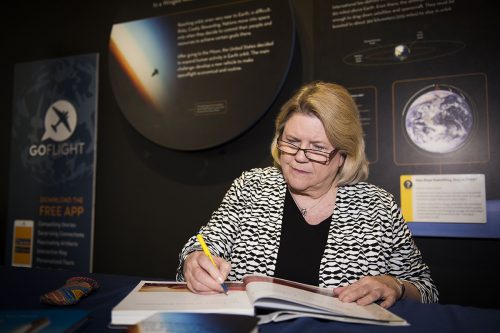A Closer Look: Books by Valerie Neal
The Smithsonian curator’s latest nonfiction book is Spaceflight in the Shuttle Era and Beyond.

The Smithsonian National Air and Space Museum bookstore displays copies of books by Valerie Neal. Photo by Lisa Helfert
A Closer Look: Books by Valerie Neal
The Smithsonian curator’s latest nonfiction book is Spaceflight in the Shuttle Era and Beyond.
Spaceflight in the Shuttle Era and Beyond: Redefining Humanity’s Purpose in Space (Yale University Press, 2017)
Valerie Neal’s magnum opus dissects three decades of human spaceflight in the shuttle era — the span of her professional life. She probes how the meaning of spaceflight in American culture is shaped by powerful images and ideas — i.e., the heroic pioneers of the 1960s conquering the space frontier, versus the pragmatic icon of the shuttle era: a “space truck” for commuting to work in orbit.
What resonates in the public psyche is often consciously framed by NASA, the media, Congress and other actors to fit their rationales (or critiques). “At times concurrently, the space shuttle was billed as delivery truck and orbiting science lab, near-Earth station and space explorer, costly disaster and pinnacle of engineering success,” Neal writes. She makes a plea for a radical new framework that engages millennials, “the ones who will have to decide whether or not human spaceflight continues.”
Discovery: Champion of the Space Shuttle Fleet (Zenith Press, 2014)

At the Smithsonian National Air and Space Museum, curator and chair of the Space History Department Valerie Neal ’71 signs copies of her books. Photo by Lisa Helfert
After 39 missions and 365 days in space — longer than any other ship in the shuttle fleet — Discovery flew into retirement. Neal launched the effort to bring the orbiter home to the Smithsonian. Today, Discovery is on permanent display in a huge hangar in northern Virginia — an exhibit that Neal curated for the National Air and Space Museum. She authored this definitive picture book on Discovery, telling its story in loving detail — complete with outlines of each mission, crew photos, “firsts,” and colorful mission patches.
Smithsonian Guides: Spaceflight: The Complete Illustrated Story – from the Earliest Designs to Plans for the 21st Century (Macmillan General Reference, 1995)
If you don’t know Apollo from Atlantis — or you’re certain the Enterprise exists only on Star Trek — this guidebook can get you up to speed. There’s a foldout timeline of space milestones, a photo glossary that illuminates the jargon, and colorful diagrams on topics ranging from the components of the shuttle to “walking” in space. The book pre-dates landmark events such as the Columbia tragedy and the International Space Station era of today. Still, it’s a useful primer on the evolution of human spaceflight.
Where Next, Columbus? The Future of Space Exploration (Oxford University Press, 1994)
Neal brings star power to this original collection of essays on our destiny in space. Well-known astronomer Carl Sagan and American paleontologist Stephen Jay Gould are among the noted thinkers who accepted Neal’s invitation to ponder “Where should we go next?” Astronaut Harrison H. Schmitt writes eloquently about his time on the moon, and how the urge to “be there” will eternally drive us to new worlds:
“This transcendent desire has carried humankind from the caves to the moon. “Video pictures and data streams” from Mars, no matter how good or how complete, will never be enough for the parents of the first Martians. For that generation of pioneers, some of whom live among us today, the moon will become merely a way station to greater adventures . . .”

Your comments are welcome
Comments
Related reading:
Features
Curator Brings Discovery to Smithsonian as NASA Considers Mars
Space historian Valerie Neal shares stories from shuttle era.
Features
Smithsonian Curator Chronicles Remarkable Life of Sally Ride
The collection highlights the achievements of the first American woman in space.
Features
Female Equality in STEM Fields
Themes of lauded film Hidden Figures linger as conversations about gender bias continue, especially in STEM fields.